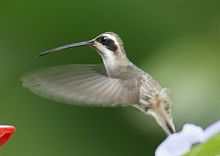| Pale-bellied hermit | |
|---|---|

| |
| Canopy Camp – Darien, Panama | |
| Conservation status | |
 Least Concern (IUCN 3.1) | |
| CITES Appendix II (CITES) | |
| Scientific classification | |
| Domain: | Eukaryota |
| Kingdom: | Animalia |
| Phylum: | Chordata |
| Class: | Aves |
| Clade: | Strisores |
| Order: | Apodiformes |
| Family: | Trochilidae |
| Genus: | Phaethornis |
| Species: | P. anthophilus |
| Binomial name | |
| Phaethornis anthophilus (Bourcier, 1843) | |

| |
The pale-bellied hermit (Phaethornis anthophilus) is a species of hummingbird in the family Trochilidae. It is found in Colombia, Panama, and Venezuela.
Taxonomy and systematics
Though the scale-throated hermit is a member of the large genus Phaethornis it seems to have no close relatives, and at one time was placed in its own genus, Ametrornis. It has two subspecies, the nominate P. a. anthophilus and P. a. hyalinus. It has been suggested that a third subspecies, P. a. fuscicapillus, be split from anthophilus. A putative subspecies P. a. fuliginosus was based on a melanistic morph that as of 2021 had not been identified to species.

Description
The pale-bellied hermit is about 13 cm (5.1 in) long. Males weigh 4.5 to 5.5 g (0.16 to 0.19 oz) and females 4 to 5 g (0.14 to 0.18 oz). This medium-sized hermit has dark green to olive green upperparts and light gray underparts. The face has a black "mask" with a buffy supercilium and a mostly white throat. The male's bill is almost straight and the female's is decurved. P. a. hyalinus has more bluish green upperparts and paler underparts than the nominate. Members of the suggested P. a. fuscicapillus have shorter wings and bills than the rest of the nominate.
Distribution and habitat
The nominate subspecies of pale-bellied hermit taken as a whole is found in central Panama; northern, central, and eastern Colombia; and western and northern Venezuela. The suggested P. a. fuscicapillus is the population in Colombia's Eastern Andes and possibly includes the Venezuelan population as well. P. a. hyalinus is found only on the Pearl Islands off the Pacific coast of Panama.
The pale-bellied hermit mostly inhabits semi-deciduous forest and also drier woodland, secondary forest, gallery forest, plantations, and brushy and thorny landscapes. In elevation it ranges from sea level to about 1,500 m (4,900 ft).
Behavior
Movement
Observations of pale-bellied hermits in northeastern Venezuela hint at regular movements but more data are needed.
Feeding
The pale-bellied hermit is a "trap-line" feeder like other hermit hummingbirds, visiting a circuit of a wide variety of flowering plants for nectar. It also consumes small arthropods.
Breeding
The pale-bellied hermit's breeding seasons appear to vary across its range but have not been fully defined. It suspends a cone-shaped nest under a drooping leaf like many other species of its genus. Its clutch size is two eggs.
|
Songs and calls Listen to pale-bellied hermit on xeno-canto |
Vocalization
The pale-bellied hermit's song has not been well described. Its calls are "rather piercing, high-pitched notes".
Status
The IUCN has assessed the pale-bellied hermit as being of Least Concern, though its population size and trend are unknown. It is uncommon to locally common in most of its range, abundant in a few regions, and occurs in several protected areas.
References
- ^ BirdLife International (2016). "Pale-bellied Hermit Phaethornis anthophilus". IUCN Red List of Threatened Species. 2016: e.T22686955A93133208. doi:10.2305/IUCN.UK.2016-3.RLTS.T22686955A93133208.en. Retrieved 30 November 2021.
- "Appendices | CITES". cites.org. Retrieved 2022-01-14.
- ^ Gill, F.; Donsker, D.; Rasmussen, P. (July 2021). "IOC World Bird List (v 11.2)". Retrieved July 14, 2021.
- ^ Hinkelmann, C., G. M. Kirwan, and P. F. D. Boesman (2020). Pale-bellied Hermit (Phaethornis anthophilus), version 1.0. In Birds of the World (J. del Hoyo, A. Elliott, J. Sargatal, D. A. Christie, and E. de Juana, Editors). Cornell Lab of Ornithology, Ithaca, NY, USA. https://doi.org/10.2173/bow.pabher1.01 retrieved November 30, 2021
- Remsen, J. V., Jr., J. I. Areta, E. Bonaccorso, S. Claramunt, A. Jaramillo, D. F. Lane, J. F. Pacheco, M. B. Robbins, F. G. Stiles, and K. J. Zimmer. Version 24 August 2021. A classification of the bird species of South America. American Ornithological Society. https://www.museum.lsu.edu/~Remsen/SACCBaseline.htm retrieved August 24, 2021
- ^ Stiles, F. Gary (1993). "Distribucion y Variacion en el Ermitaño Carinegro (Phaethornis anthophilus) en Colombia". Caldasia. 18 (86(1)): 119–129. ISSN 0366-5232. JSTOR 23641326.
External links
| Taxon identifiers | |
|---|---|
| Phaethornis anthophilus |
|
